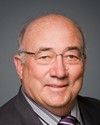I will be the spokesperson.
Thank you very much, Mr. Chairman, and thank you, committee, for inviting us to come before you today.
My name is Stephen Cheasley. I am president of the Canadian Railroad Historical Association.
I am here today with Exporail's Director General, Ms. Marie-Claude Reid, and our administrator and secretary, Mr. Daniel Laurendeau.
I would like to start off by talking about the Canadian Railroad Historical Association. It is a non-profit, federally incorporated organization founded in 1932 that owns and operates Exporail, the Canadian Railway Museum, in Delson—Saint-Constant, Quebec. The CRHA has 1,000 members and 14 divisions across Canada and publishes a bimonthly magazine on railway history, Canadian Rail--which I have a copy of here--and publishes books as well. We have just published a recent book on Ottawa streetcars, which I thought was appropriate.
Exporail, established in 1961, is Canada's largest railway museum and is considered by museum experts as one of the best railway museums in the world. Exporail is situated on 50 acres of land containing three display buildings, with a total of 125,000 square feet of exhibition space, a 25,000-square-foot reserve building, an 1882 country station, a restoration shop, and a turntable. Exporail features rides on a one-mile tramway line, a two-mile railway line, and an outdoor miniature railway. It also has an extensive HO-gauge model railway installation.
The facility also includes a library, an archives centre, temporary exhibit spaces, a multi-purpose hall, and food and retail spaces. It is designed to appeal to Canadians of all ages.
The Exporail collection is composed of 168 locomotives, tramways, and other pieces of rolling stock, and over 250,000 small objects, models, books, plans, photographs, pieces of railway art, and archival items.
In a recent report by Lord Cultural Resources Planning & Management Inc., a leading museum consulting firm, the collection is deemed to be a national collection rated as world-class. Indeed, in 1978 the museum was designated as a specialized museum for railways by the federal government, a role it continues to fulfill today.
The Exporail collection has items from the first railway in Canada, the Champlain and Saint Lawrence Railroad, built in 1836 between La Prairie and Saint-Jean, Quebec, and from Canada's entire subsequent railway history up to the prototype of a hybrid switching locomotive recently invented in Canada. It is the most comprehensive collection of Canadian railway historical material in existence.
Since the design of Exporail permits pieces of rolling stock to be moved on their own wheels, some of the rolling stock from the Exporail collection is lent from time to time to other railway museums across Canada for exhibition. In addition, travelling displays about Canadian railways are prepared and sent to other museums. The Revelstoke Railway Museum currently houses CPR steam locomotive 5468 on loan from the Exporail collection and has recently shown our travelling exhibit on women in the railways.
For the last 170 years railways have played an important role in the development of this vast country. Due to the size of the country, Canadians have had to develop world-class transportation systems, and today Canadian railroads are certainly world-class. Indeed, two years ago the U.S. magazine Trains named CN as the number one railroad in the world.
The Canadian railways, with their twin ribbons of steel, opened Canada for settlement and framed its infrastructure. Many towns and cities in Canada owe their origin to the coming of the railway. Many a Canadian family has a proud railroader in its background. The railways were and still are the lifeblood of Canada, moving a large percentage of Canada's goods and materials. Indeed, I was told last week by the Railway Association of Canada that no fewer than 63 million passengers were moved by trains last year, and over 65% of the material that moved by surface was moved by trains.
From a political standpoint, the completion of the CPR on November 7, 1885, provided the basis for the Canadian Confederation as we know it today. Canada, more than most countries, was dependent on the development of the railways for its very existence, and that is why it is so important that this part of Canada's heritage be properly preserved for future generations. Railway history is a major part of the story of Canada, and it must be cherished, nurtured, and retold to all Canadians.
Here's a quote from the Lord report:
Exporail is the only museum in Canada that tells this story in any depth and in fact is the only one with the mandate, expertise, and collection base to do so effectively. This outstanding Canadian collection is a unique resource that offers Canadians the opportunity to tell this story with the original material culture that made it possible.
However, the Canadian railways are always improving and changing with the result that preserving the railway heritage presents the ongoing challenge of rescuing items of historical importance before they are lost to the scrapyard or to other countries like the U.S.
The non-rolling-stock part of the collection is now housed in adequate environmental conditions, thanks to our new $12 million pavilion. One-third of the rolling stock in our collection, as distinct from the non-rolling stock, is now in adequate environmental conditions. One-third of the rolling stock is sheltered from the elements, but not in adequate environmental conditions, and the remaining third is totally exposed to the elements. The items of rolling stock that are not in adequate environmental conditions or are totally exposed to the elements are slowly but surely deteriorating, and will be lost if not properly conserved. This matter is urgent.
Railway rolling stock, by its nature, is very big, but also very fragile and requires big buildings to house it, with sophisticated environmental systems to protect the items from deterioration. Due to these requirements, such buildings are costly to construct and operate.
In addition to the Exporail collection, there are some other historically significant items of rolling stock scattered among other railway museums across Canada, but very few are well conserved, due to the lack of financial resources.
In England and Europe, most national railway museums and their collections are funded entirely by national governments. The railway museum considered to be the best in the world is located in York, England, and is entirely funded by the British government. Moreover, admission is free, as in all the state museums in England under the new admissions policy introduced in 2000. The National Railway Museum in York has over 850,000 visitors per year. Steamtown in the United States is funded by the U.S. federal government through the National Parks Service, which operates that museum. The Danish Railway Museum in Odense is owned and operated by the Danish State Railways, and the Swedish Railway Museum in Galve is operated by Sweden's state authority for railways.
Over the past 45 years, Exporail has received capital grants for certain infrastructure and project grants from the museum assistance program of the federal government, but no operating grants for the preservation, conservation, and interpretation of this important Canadian collection. The existing federal policy is not to provide operating grants to non-federal government museums. As a result, Exporail's operating funds have been largely self-generated, with additional support for the last 27 years from operating grants from the Quebec government.
In essence, for 45 years Exporail has played the role of Canada's national railway museum with operating support from the railway industry, the Quebec government, local municipalities and private companies and individuals, but not from the federal government. In reality, Exporail, the Canadian Railway Museum, has been a national public-private partnership, which owns and operates the national railway collection, but without the national level of government as a full participant.
A public-private partnership is a cost efficient and effective way for the federal government to assure all Canadians that their Canadian railway heritage is being properly preserved and conserved for future generations of Canadians.
In contrast, the federal government now fully funds, through the existing national museums, institutions dedicated to aviation, agriculture, nature, mail, science and civilization. Surely the heritage of the Canadian railways, railways that built and are still building this great country of ours, deserves equal treatment.
We would now like to make two recommendations. The first recommendation is that the federal government should acknowledge and assume its responsibility to provide adequate funding for the preservation, conservation, interpretation and display of Canada's proud railway heritage. Secondly, the federal government should become a full partner in Exporail's national public-private partnership as soon as possible, and contribute funding for the preservation, conservation, interpretation and display of the Exporail collection in adequate environmental conditions for all to enjoy.
Mr. Chairman, that's the end of the statement we'd like to make.









